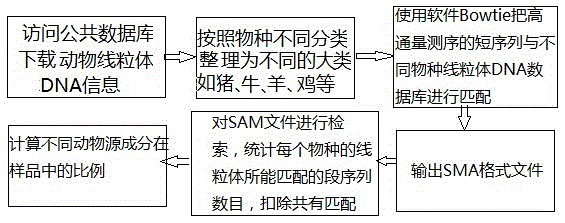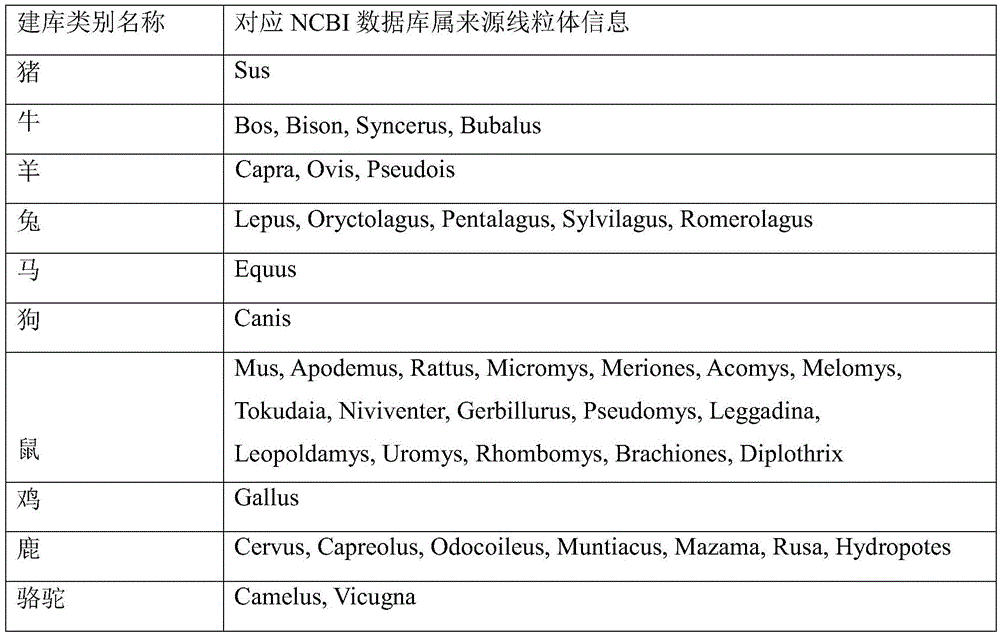High-throughput sequencing-based animal-derived ingredient identification method and application thereof
An animal component, high-throughput technology, applied in the direction of biochemical equipment and methods, microbial measurement/inspection, etc., can solve the problems of effective identification of animal source components that cannot be mixed and unknown animal source components, and achieve flexible and changeable classification methods , Improve the speed of information acquisition and broad application prospects
- Summary
- Abstract
- Description
- Claims
- Application Information
AI Technical Summary
Problems solved by technology
Method used
Image
Examples
Embodiment 1
[0038] Weigh 2 g of fresh mutton, homogenize, add CTAB lysate and protease at 50°C, incubate for 2 h, take 1 ml of lysate, centrifuge at 12000 g for 10 min, take supernatant, add an equal volume (chloroform: isoamyl alcohol: saturated phenol) ( 24:1:25), mix upside down, centrifuge at 12000g for 10min, take the supernatant, add (chloroform:isoamyl alcohol) (24:1), mix upside down, centrifuge at 12000g for 10min, take the supernatant, add 2 times ice-free Water ethanol, or 0.6 times isopropanol, place for 30min, centrifuge at 12000g for 10min, wash twice with 70% ethanol, air dry at room temperature, add ddH 2 O 100uL. Using Nanodrop to analyze the concentration and quality of extracted DNA, DNA (ng / μL): 356.05, OD (260 / 280): 1.88, OD (260 / 230): 2.17.
[0039] The sample was taken and diluted with pure water, the DNA was ultrasonically disrupted using Covaris S220, and a 200bp fragment was recovered by electrophoresis. The TruSeqDNASample Preparation kit was used to build a li...
Embodiment 2
[0047] Weigh 2 g of homogenized meat samples from pigs (commercially available), cattle (commercially available), sheep (commercially available), chicken (commercially available), rabbits (commercially available), and rats (laboratory source) respectively, add SDS to crack solution and protease at 55°C, incubate for 2 hours, take 1ml of the lysate, centrifuge at 12000g for 10min, take the supernatant, add an equal volume (chloroform: isoamyl alcohol: saturated phenol) (24:1:25), mix upside down, 12000g Centrifuge for 10 minutes, take the supernatant, add (chloroform:isoamyl alcohol) (24:1), mix upside down, centrifuge at 12000g for 10 minutes, take the supernatant, add 2 times ice-free ethanol, or 0.6 times isopropanol, and let stand for 30 minutes , centrifuged at 12000g for 10min, washed twice with 70% ethanol, air-dried at room temperature, added ddH 2 O 100uL. Extracted DNA concentration and quality were analyzed using Nanodrop (Table 3).
[0048] Table 3 DNA concentrati...
Embodiment 3
[0058] Weigh pig (commercially available) 1.05g, cattle (commercially available) 10.12g, sheep (commercially available) 20.36g, chicken (commercially available) 5.29g, after homogeneous mixing, weigh the mixed sample 5g, add SDS The lysate and protease were incubated overnight at 55°C, 1ml of the lysate was taken, centrifuged at 12000g for 10min, the supernatant was taken, and an equal volume (chloroform: isoamyl alcohol: saturated phenol) (24:1:25) was added, and mixed evenly by inversion. Centrifuge at 12000g for 10min, take the supernatant, add (chloroform:isoamyl alcohol) (24:1), mix upside down, centrifuge at 12000g for 10min, take the supernatant, add 2 times of ice absolute ethanol, or 0.6 times of isopropanol, and place 30min, centrifuge at 12000g for 10min, wash twice with 70% ethanol, air dry at room temperature, add ddH 2 O 100uL. Use Nanodrop to analyze the concentration and quality of extracted DNA DNA (ng / μL): 541.78; OD (260 / 280): 1.78; OD (260 / 230): 2.02. Thi...
PUM
 Login to View More
Login to View More Abstract
Description
Claims
Application Information
 Login to View More
Login to View More - R&D
- Intellectual Property
- Life Sciences
- Materials
- Tech Scout
- Unparalleled Data Quality
- Higher Quality Content
- 60% Fewer Hallucinations
Browse by: Latest US Patents, China's latest patents, Technical Efficacy Thesaurus, Application Domain, Technology Topic, Popular Technical Reports.
© 2025 PatSnap. All rights reserved.Legal|Privacy policy|Modern Slavery Act Transparency Statement|Sitemap|About US| Contact US: help@patsnap.com



